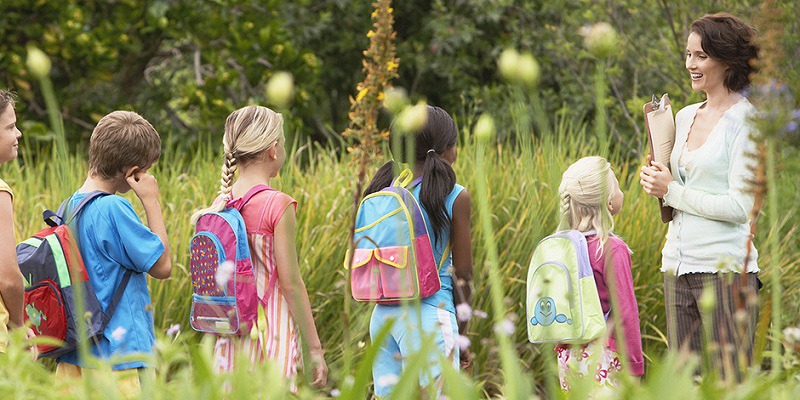
Introduction: The shift towards experiential learning
Education is evolving, and there’s a noticeable shift towards experiential learning. Traditional classrooms are no longer the sole place for knowledge acquisition. Instead, the world outside these four walls offers rich opportunities for students to grow and thrive. From bustling city streets to serene nature trails, learning can happen anywhere. As educators and parents recognize this potential, they’re embracing new methods that bring lessons to life in profound ways. Let’s dive into why understanding the importance of learning outside the classroom has become essential in today’s educational landscape.

Benefits of Learning Outside the Classroom
Learning outside the classroom offers a wealth of benefits that traditional education often overlooks. One major advantage is the enhancement of critical thinking skills. When students engage in hands-on experiences, they learn to analyze situations and make informed decisions.
Another significant benefit lies in the real-world application of knowledge. Students can connect theoretical concepts with practical scenarios, reinforcing their understanding and retention of information.
Social and emotional intelligence also sees marked improvement through experiential learning. Collaborative projects encourage teamwork, empathy, and communication—skills essential for success beyond school walls.
These enriching experiences foster a sense of curiosity and motivation as learners explore new environments. The excitement found in outdoor settings stimulates engagement unlike any classroom can provide.
– Enhanced critical thinking skills
Learning outside the classroom fosters critical thinking in ways traditional education often can’t. When students engage with real-world problems, they learn to analyze situations from multiple perspectives.
This hands-on approach encourages them to ask questions and seek solutions actively. Instead of merely absorbing information, they become problem solvers. This transformation is crucial in developing their analytical skills.
Outdoor experiences challenge learners to evaluate evidence and make informed decisions based on their findings. They must think independently while working collaboratively with peers, enhancing their ability to articulate ideas clearly.
Moreover, navigating unexpected challenges during these activities sharpens adaptability—a key component of critical thinking. It’s about learning how to pivot when plans change unexpectedly or when faced with complex scenarios.
In essence, enhanced critical thinking skills emerge naturally when students step beyond textbook confines into dynamic environments that demand engagement and thoughtful reflection.
– Real-world application of knowledge
Real-world application of knowledge bridges the gap between theory and practice. When students step outside traditional learning environments, they encounter situations that challenge their understanding.
In a classroom, concepts can seem abstract. However, applying these ideas in real-life scenarios transforms them into tangible skills. For instance, a science lesson about ecosystems becomes vivid during field trips to nature reserves. Students observe interactions firsthand.
Moreover, internships allow learners to take on roles relevant to their studies. They experience workplace dynamics and gain insights that textbooks alone cannot offer. This exposure cultivates adaptability and problem-solving abilities.
As students engage with communities through service-learning projects, they witness the impact of their actions. Whether planting trees or volunteering at shelters, each task reinforces their knowledge while fostering empathy and responsibility toward society.
Experiential learning enhances retention by making education relevant and meaningful—a crucial element often neglected within four classroom walls.
– Improved social and emotional intelligence
Learning outside the classroom fosters improved social and emotional intelligence. When students engage in real-world experiences, they encounter diverse perspectives and challenges.
This exposure enhances their ability to empathize with others. They learn to navigate different social dynamics, which is crucial for building relationships.
Hands-on activities often require teamwork. Collaborating with peers teaches communication skills that are essential in both personal and professional settings.
Additionally, facing setbacks during these experiences helps develop resilience. Students learn how to manage emotions effectively when confronted with obstacles.
Experiential learning also encourages self-awareness. As individuals reflect on their interactions, they gain insights into their own strengths and areas for growth.
Engaging outside traditional educational boundaries cultivates a well-rounded individual who understands the importance of emotional connections in everyday life.
Types of Learning Outside the Classroom
Learning outside the classroom takes many forms, each offering unique benefits. Field trips and excursions immerse students in environments that bring their curriculum to life. Whether visiting a museum or exploring nature, these experiences spark curiosity and a deeper understanding of subjects.
Service-learning projects combine community service with academic study. Students engage directly with local issues, fostering empathy while applying skills learned in class. This hands-on approach not only benefits the community but also enriches student perspectives.
Internships and apprenticeships provide an invaluable glimpse into professional worlds. Hands-on experience helps students apply theoretical knowledge to real tasks. They gain insights into workplace dynamics while developing essential networking skills.
Each type of learning outside the classroom opens doors to personal growth and exploration, making education more dynamic and relevant. Engaging with diverse settings prepares students for life beyond textbooks.

– Field trips and excursions
Field trips and excursions offer students an engaging way to experience learning firsthand. Stepping outside the traditional classroom setting, learners immerse themselves in environments that bring their lessons to life.
Visiting museums, historical sites, or nature reserves sparks curiosity. Students encounter artifacts and ecosystems they’ve only read about before. This tangible interaction fosters deeper understanding and retention of knowledge.
Moreover, these experiences build excitement around education. The thrill of exploring new places ignites a passion for discovery that textbooks alone often cannot inspire.
Field trips also promote teamwork and collaboration as students navigate unfamiliar surroundings together. They learn valuable social skills while forming stronger bonds with peers.
Such excursions provide rich opportunities for experiential learning that extend well beyond the confines of any classroom walls.
– Service-learning projects
Service-learning projects blend education with community service. They allow students to engage in meaningful work that addresses real societal needs. This hands-on approach fosters a deeper understanding of course material.
Participating in these projects enhances civic responsibility and empathy. Students learn the impact their actions can have on others, developing a sense of purpose beyond textbooks.
Moreover, these experiences cultivate teamwork and communication skills. Working alongside peers and community members encourages collaboration and diverse perspectives.
Students often leave with newfound confidence and motivation, realizing they can effect change within their communities. The connection between academic theories and practical application solidifies learning in ways traditional classrooms may not achieve.
Through service-learning, learners become active participants rather than passive recipients of information, enriching both personal growth and educational outcomes.
– Internships and apprenticeships
Internships and apprenticeships offer invaluable experiences that go beyond traditional learning. They allow students to immerse themselves in real-world environments, bridging the gap between theory and practice.
Through internships, individuals can apply classroom knowledge while gaining insights into professional dynamics. This firsthand exposure cultivates essential skills such as problem-solving and adaptability.
Apprenticeships provide a structured pathway for those entering trades or specialized professions. Participants learn directly from seasoned experts, honing their craft under expert guidance.
Both options foster networking opportunities that can lead to future career prospects. Building relationships within an industry is crucial for success in today’s competitive job market.
Moreover, these experiences enhance resumes significantly. Employers often prioritize candidates with hands-on experience when making hiring decisions.
Engaging in internships and apprenticeships not only enriches personal growth but also prepares learners for the complexities of the workforce ahead.
Case Studies: Successful Examples of Learning Outside the Classroom
One shining example of learning outside the classroom is the “Genius Hour” initiative in schools. This program empowers students to explore their passions for one hour each week. Students have created everything from coding apps to building community gardens, fostering creativity and self-direction.
Another noteworthy case is a Chicago-based nonprofit that connects high schoolers with local businesses for internships. These students gain firsthand experience while developing job-ready skills. The impact on their confidence and career readiness has been profound.
In rural communities, educational field trips have transformed traditional lessons into engaging experiences. One particular trip allowed students to work alongside scientists studying local ecosystems. This hands-on approach made complex subjects like biology tangible and exciting.
These examples highlight how diverse methods can enhance learning beyond conventional settings, illustrating the transformative power of real-world experiences in education.
Challenges and Solutions for Implementing Learning Outside the Classroom
Implementing learning outside the classroom can come with its own set of challenges. One major hurdle is the logistical aspect. Coordinating field trips or service-learning projects often requires extensive planning and resources that schools may lack.
Another challenge is resistance from educators and parents who prioritize traditional teaching methods. They might question the effectiveness of experiential learning compared to textbook education.
To overcome these issues, schools can start small by integrating short local excursions into their curricula. Pilot programs allow for gradual adaptation without overwhelming staff or students.
Engaging parents in discussions about the benefits of outdoor learning can also foster support. Workshops showcasing successful case studies might help sway skeptics and build a community around innovative educational practices.
Collaboration with local businesses for internship opportunities creates win-win situations, enriching student experiences while fostering community ties.

How to Incorporate More
To incorporate more learning outside the classroom, educators and institutions can begin by embracing a flexible curriculum. Start small; plan field trips that connect with current lessons or concepts being taught in class. These excursions can spark curiosity and deepen understanding.
Consider implementing service-learning projects that align with community needs. This not only reinforces academic knowledge but also fosters a sense of responsibility among students. Collaborations with local organizations can create opportunities for hands-on experiences.
Another effective approach is to establish partnerships with businesses for internships or apprenticeships. Students gain invaluable skills while contributing meaningfully to real-world environments.
Additionally, teachers should encourage exploration beyond traditional settings—outdoor classrooms, museums, and cultural events are all excellent venues for experiential learning.
Engaging parents and communities is crucial too. Encourage them to share their professional expertise through workshops or mentorship programs that enhance student learning.
By integrating these elements into educational practices, we pave the way for enriching experiences that extend well beyond school walls, ultimately fostering lifelong learners who are ready to tackle real-life challenges head-on.



Leave a Reply